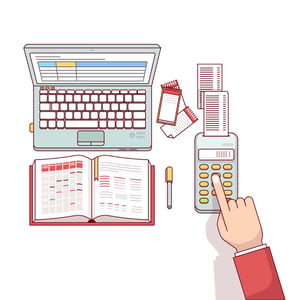How to start a budget in 6 simple steps
With all the interest rate hikes, we've all had to pull in the reigns a bit. What this often translates to is tightening the monthly budget. For some, it may be starting a budget for the first time. Whatever your reason for looking into budgeting, having a budget can be your first step towards financial freedom. Alternatively, if you've found yourself slipping a bit, this is a way to get back on top of things. Not convinced yet?
Here are 4 reasons you should start a budget:
- With a budget, you're more likely to cover all your expenses, and prioritise what needs to be paid first. This means you have a greater chance of not missing payments.
- By tracking your monthly income and monthly expenses, you can more easily save towards big financial goals.
- You can set money aside for an emergency fund so that you're protected when unexpected expenses do arise.
- If you find there is always more month than money, creating a budget is a good idea to really understand where your money is currently going, where you'd like it to go, and to bridge this gap, the areas, based on your budget, you can adjust your spending.
How to start budgeting for the first time
When starting a budget, it's important to remember that there is no template that works for everyone. This is why setting up a personalized budget for yourself is important. These steps will help you:
◉ Step 1 - Note your net income
This step includes finding out how much money you take home each month after tax has been deducted. Here you can check your payslip your company issues you to find out the exact amount.
If you have a partner or family member that is relevant to your budget, you can include their income to your monthly household income too. Another factor to consider is if you have any other income from hobbies or a side business.
◉ Step 2 - Track your spending
You need to track what you spend money on. Here you can check your bank statements to really gain an understanding of what you're spending your money on. By doing this, you can learn what you tend to spend the most money on and where you can cut back on spending. You may even be surprised to learn where your money is going.
Once you know your expenses and spending habits, you can decide what you can cut costs on. You are most likely not able to cut costs on you fixed costs like your expenses such as a bond or car payments. So instead look at your variable costs, such as entertainment and groceries, which change month to month.
◉ Step 3- Set goals
It is always helpful to have a list of your goals as this gives meaning and purpose to how you use your hard-earned money. This is also where your 'why' comes in.
Why do I have to have a budget?
- It may be because you have big financial goals you want to reach.
- It may be that you want to become more self-aware about where and what you're spending your money on.
- It may be that you're currently struggling financially.
Whatever it is, take some to time to figure out your why and what goals you want to reach.
When setting your goals, it may be helpful to remember:
- Short-term goals should take no longer than a year to achieve.
- Long-term goals such as saving for retirement or your child’s education take time to reach.
Remember that goals do not have to be set in stone, but identifying your priorities before you start planning a budget will help. For example, it might be easier to cut spending if you know your short term goal is to reduce credit card debt.
◉ Step 4- Make a plan
Use the previous identification of your fixed and variable expenses to predict what you will need money for throughout the month. Fixed expenses should be easy to predict. You can use your past spending habits to estimate how much you will need for your variable expenses.
The hardest step is deciding what you NEED and what you WANT. It is difficult to let some luxuries go, but just be honest with yourself, it will only end up benefiting you and your future.
◉ Step 5- Adjust your habits
Once you have completed the above steps, you have what you need to create your budget. After documenting your income and spending you can start to see what you are spending too much money on. This will help you to realize what you can cut back on so that you can work towards achieving your goals.
If you do not have enough money freed up by the end of your budget, reevaluate your spending. Start asking yourself the hard questions.
- Do you really need to spend money on, for example, going to a movie instead of watching TV at home?
- Do you really need the fastest internet connection available?
It's important here to remember that being too restrictive with yourself might not be a good thing either. Look for areas to cut back, but be reasonable, and if you can, throw in some incentives to keep yourself going.
What may this look like?
If you really enjoy going to the hair salon, instead of cutting it out completely, see if you can cut back to just once a month.
◉ Step 6 - Keep checking in
Check your budget on a regular basis to make sure you are sticking to it. Check it many times during the month. The best way to stick to your budget is to check your budget before you buy something to make sure you can really afford it.
Making yourself a budget is the best way to work towards achieving your goals. It is also the best way to get out of debt. Your budget is a way to support and motivate you constantly towards achieving your goals and achieving financial wellness.
► Click below for your free handy budgeting spreadsheet to help you get started:
If your budget shows that a significant amount of money is going towards servicing your debt or you find you’ve missed debt repayments, fill in the contact form. We can help.
I have a budget, but I still can't manage to make it to the end of the month
If you have a budget and you've cut back on everything you simply can, and you still aren't able to make ends meet, you should consider debt counselling at Meerkat. Why? You will finally have room to breathe, and a real chance at becoming debt-free.
Learn more about debt counselling here by reading this blog post.
Do you know your debt-to-income ratio?
Another way to check that you may be over-indebted or at least in dangerous territory is to find out your debt-to-income ratio.
A debt-to-income ratio compares how much you earn to your expenses and how much you spend.
Find out what your debt-to-income ratio is by downloading our free budgeting template.
Download our free budgeting template
How do I know if I am over-indebted?
Your percentage of income spent is another term for your debt-to-income ratio. Any percentage higher than 60% should be a cause for concern, and you may want to learn more about debt review to successfully reduce this amount, and finally have peace of mind.
Read: What are the advantages of debt review



